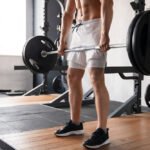Close-Grip Bent-Over Dumbbell Row: Exercise Overview
The close-grip bent-over dumbbell row is a variation of the traditional bent-over row, specifically designed to target the upper back muscles, including the latissimus dorsi, rhomboids, and trapezius, with increased emphasis on the mid-back and biceps due to the closer hand positioning. This exercise uses a narrower grip to enhance muscle activation in the central back, promoting strength and definition.
As a foundational pulling movement, the close-grip row supports balanced muscle development and is ideal for addressing back strength imbalances. The back responds well to varied stimuli, so experimenting with torso angles and grip positions can optimize growth (Schoenfeld, 2010). This versatile exercise fits seamlessly into back workouts, upper-body sessions, pull routines, or full-body training programs, making it suitable for both aesthetic and functional goals (Wirth et al., 2016).
How to Perform the Close-Grip Bent-Over Dumbbell Row
- Stand with feet hip-width apart, holding a dumbbell in each hand with a neutral grip (palms facing each other), hands positioned closer together than shoulder-width.
- Hinge at your hips, pushing them back until your torso is nearly parallel to the floor or slightly higher, maintaining a slight bend in your knees.
- Brace your core to keep your spine neutral—this is your starting position.
- Drive your elbows back and retract your shoulder blades, pulling the dumbbells toward your lower chest or upper abdomen, keeping them close to your body.
- Pause briefly when your elbows reach or slightly pass your torso, squeezing your back muscles for maximum contraction.
- Lower the dumbbells back to the starting position with control, maintaining tension in the back muscles.
- Repeat for the desired number of repetitions.
Tips for Optimal Performance
- Maintain Spinal Alignment: Engage your core to prevent excessive arching or rounding of your spine, reducing stress on the lower back and enhancing back muscle activation (McGill, 2010).
- Control the Movement: Perform the pull and descent slowly to maximize muscle engagement and avoid momentum, which improves effectiveness and reduces injury risk (Schoenfeld, 2016).
- Adjust Head Position: Test a neutral neck (chin tucked) or slightly forward gaze to find the most comfortable position for your posture, avoiding forward head jutting (Wirth et al., 2016).
- Use a False Grip if Needed: If biceps dominate the movement, try a thumbless grip to shift focus to the mid-back and lats, reducing arm involvement.
- Allow Scapular Movement: Let your shoulder blades retract during the pull and protract slightly during the descent to optimize rhomboid and lat engagement.
- Keep Elbows Close: Maintain a close-grip position to emphasize the mid-back and ensure elbows track near your torso for targeted muscle activation.
- Breathe Properly: Inhale as you lower the dumbbells and exhale as you pull to support core stability and muscle oxygenation.
Building back strength with close-grip rows? Learn how they fit into our Ultimate Guide to Muscle Groups.







